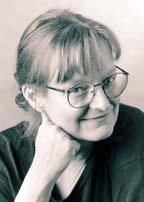| The
Winners!
Fiction
short list
Poetry short list:
John
Cayley
Geniwate
Hilary
Mosher-Buri
Dane
Watkins
Kim White
Komninos
Zervos
Judges
Judging
criteria
2001
Awards Ceremony |
|
Comments by Heather
McHugh, Poetry Judge
|

Heather McHugh
|
A bravura belle-lettristic performance
that could have existed in no other medium, Windsound
reveals the power of letters, even as it plays with
the limits of literal intelligibility. It explores the
power of sequences, even as it plays with non-sequitur.
All the more elegant for its austerities, this work
was composed exclusively for alphabet and windpipes.
Granular in ways both visual and vocal, both structural
and semantic, the material constantly dissolves and
re-composes, and in doing so, gives rise to a host of
impressions. Fields of floating phonemes and morphemes
sometimes assemble into patterns-forming meaningful
phrases and sentences-only to morph away, again, before
our ears and eyes. Never before has a visual field so
significantly deepened the psychic impression of Freud’s
"mystic writing pad" --the appearance and disappearance
of the writing on which Freud famously likened to "the
flickering up and passing away of consciousness in the
process of perception." Hear hear. That’s got Windsound
written all over it.
Some of the patterns that emerge suggest
transliterations from tongues other than English --
glimmers of Asiatic and Scandinavian and Slavic languages
accumulate into, and then pass out of, the shifting
lit-scape: the listener/watcher, variously disoriented
and disoccidented, grows alert to shades and shapes
of meaning. Over time, a narrative seems to arise --
an extrovert traveler plunges through a world of languages
abroad; a sleepy traveller is submerged in his own language’s
doze and drift. Words arise from, and sink back into,
a phonetic environment at some point expressly identified
with that of a hostel at night. There are verb-ephemera,
ghost-words, host-words. We grow duly wary as “I’ll
have to kill you myself” emerges into intelligibility
-- kill what, we wonder? a word, a memory, a being?
Just how hostile is this hostel? Eventually we get whiffs
of elegiac occasion: The piece is evidently, then, a
sort of mystery as well.
The attention this art requires of
us is both somatic and semantic: physically, one cannot
notice all at once the many changing elements displayed.
To get our meaning-fix we focus on certain phrases or
sequences, and in the process have to miss other portions
of the field. Don't let that bother you: missing is
one of the themes of the piece. And anyway the patterns
of our shifting attentions themselves become revealing.
A long-time logophile and translator of venerable Chinese
poetry, Cayley was also an early explorer of electronic
media. This present work bears the mark of his hybrid
affections. Ranging through resources ancient and avant-garde,
he shows us that both are of poetic moment. Memory informs
meaning; it can look forward. Cayley is a morphologist
who loves morphing and logos alike. In more ways than
one, in the course of its unwinding, "windsound" analyzes
mindfulness itself.
Let me add, as a final note, my conviction
that even the flashiest technical motion remains artistically
static unless it bespeaks significant emotion. Instrumentally
as promising as elegiac, Windsound is able to
do just that. Eloquently it announces the fact, within
a larger and unfolding human story, that letters really
matter.
HONORABLE MENTIONS:
1) KOMNINOS ZERVOS: cyberpoetry underground A perceptual joy-ride, full of
visual attractions and sonic energies, cyberpoetry
underground is notable for its sheer momentum and
solid graphic punsmanship. Animated text, three-dimensional
letter-forms and 360-degree views turn electronic space
into an extra-literary passage, certain areas of which
the viewer can negotiate. At the end of some tunnels
are the objects of cybertext poems, graffitissimi ultimately
serving to remind us that getting there can be more
than half the fun. For romping humor, cinematic verve
and swerve, cyberpoetry underground earned its
place among the top three.
2) DANE: him Exquisite, iconic visual-design features are counterpoised
with more mundane magazine text-snippets referring (pronominally)
to men. Because the snippets themselves are appropriated
material, the whole collage can be read as a critique
of socio-journalistic constructions of male identity.
But the greatest power of the piece resides in its truly
striking graphic design elements (of which an image
of two birds pecking at seed, as objective correlative
for marriage, is one unforgettable instance). The viewer
gets caught up in exploring (and exhausting) the trigger-mechanisms
for text-sequences (the mix-and-match effects can be
very funny). In a sense, the piece reveals the underlying
limits of our instrumental freedom. But ultimately it
was the elegance of the designer images, with their
power of juxtapositive commentary, that earned this
piece its place in the top three. |
|